Written by Táine King, photographed by Táine King
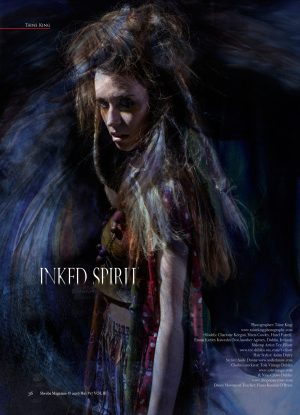 Táine King is a fashion and film photographer based in Dublin, Ireland. Having recently shot a fashion editorial based on the marking if Native American horses we spoke to her about her inspiration and her concept for the shoot.
Táine King is a fashion and film photographer based in Dublin, Ireland. Having recently shot a fashion editorial based on the marking if Native American horses we spoke to her about her inspiration and her concept for the shoot.
I loved horses as a kid. I would walk up to my uncles fields and stand at the gate for hours and just watch the horses walking around. I found a real calmness and also a real strength in them and I always wanted to be around them. So when I started to see images of Native American horses I was so excited as I had never seen them before. What interested me even more was the markings and the ink decorations on the horses. Now I am talking about a time when we didn’t have the internet so encyclopedias were my only source of information. But there just wasn’t enough imagery for me. What these images did was inspire me to start drawing, I couldn’t get enough of them so I use to start drawing my own and making up my own stories within them. When I was in school I based my art exams on the spirit of the Native American Horses. These horses are what helped me to start story telling within my imagery. They still intrigue and inspire me today.
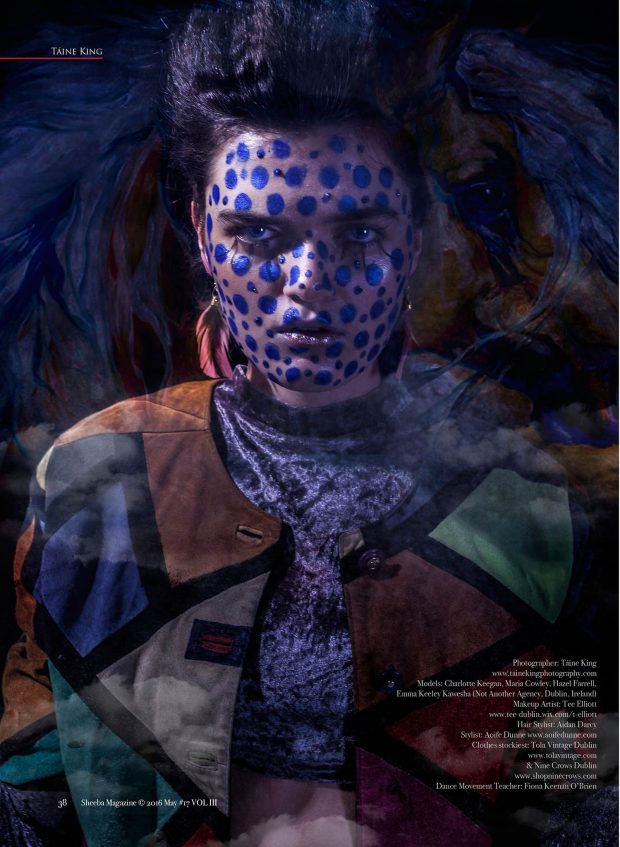
War Horse – My Obsession with Indian Symbolism
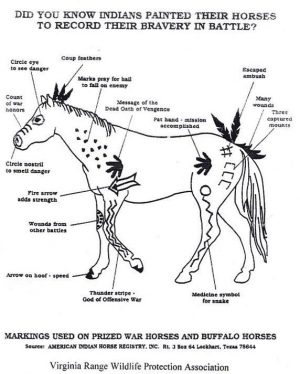 Many pictures and images of Native Americans depict the Indians in full War Paint and also their horses with powerful ink symbols that had many different meanings. An Indian horse was often painted in preparation for battle. Specific symbols were used. The designs and symbols painted on horses were believed to hold magical powers for protection and to indicate previous victories in battle. The Native American Indian valued their horses and held them in the highest esteem. Going into battle was dangerous for both the Native American and his horse. It therefore made sense to apply war paint and inks to their horses as well as themselves. The achievements of warriors were often reflected in the symbolic images of their war paint. Their clothes, tepees and all of their belongings, including their war horse, was decorated with the symbolism of their achievements or their various spirit guides. Every element of War Paint on the face and body of an American Native Indian had meaning. As did the symbols that decorated their Mustang horse. Some of the symbols meanings I used in the editorial are as follows.
Many pictures and images of Native Americans depict the Indians in full War Paint and also their horses with powerful ink symbols that had many different meanings. An Indian horse was often painted in preparation for battle. Specific symbols were used. The designs and symbols painted on horses were believed to hold magical powers for protection and to indicate previous victories in battle. The Native American Indian valued their horses and held them in the highest esteem. Going into battle was dangerous for both the Native American and his horse. It therefore made sense to apply war paint and inks to their horses as well as themselves. The achievements of warriors were often reflected in the symbolic images of their war paint. Their clothes, tepees and all of their belongings, including their war horse, was decorated with the symbolism of their achievements or their various spirit guides. Every element of War Paint on the face and body of an American Native Indian had meaning. As did the symbols that decorated their Mustang horse. Some of the symbols meanings I used in the editorial are as follows.
Red hand : The horse’s Battle Scars (always painted red) and the Pat Hand Print (left hand drawn on the horse’s right hip) were the highest honors. The Pat Hand Print was always reserved exclusively for the horse who had brought his master back home from a dangerous mission unharmed. Meaning Courage, the highest honour a horse can have.
Other hands symbols. Right/left hand prints were outlined upon the horse’s chest, which showed that he’d knocked down an enemy. For the men who would be going on a do-or-die mission, the Upside-down Handprint would be used. It was the most prized symbol a warrior could place on his horse.
Bars on the horse’s neck: means the number of war parties horse and rider have been in together.
A circle around the horse’s eye and nostrils: for alert vision and a keen sense of smell.
Broken arrow: a ‘Peace,’ symbol used when settling tribal disputes.
Firing arrow across shoulder: adds strength to the horse
Thunder and lighting down the left leg: for power and speed
Dots all over the head and chest: praying for hail to fall on the enemy
Meanings of Colours
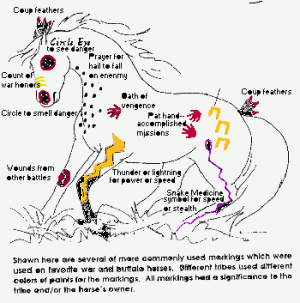 Red colour symbolised war, blood, strength, energy and power.
Red colour symbolised war, blood, strength, energy and power.
Black was used to symbolise victory and might be applied to the horse before returning home to the camp.
White colour symbolised mourning but might also mean peace.
Blue Colour Symbolised wisdom and confidence.
Yellow Colour Symbolised the colour of death. Yellow indicated that the wearer and horse were brave and were willing to fight to the death.
Green Colour Symbolised endurance, and is seen as a great healing power and believed to improve vision – green circles as well as red might be painted around the eyes of a horse.
Purple colour symbolised power, mystery and magic”.
The Symbols and colours showcased in the editorial were put together by a very talented team. Tee Elliott who is incredible makeup artist created the makeup looks from some of these symbols and through makeup and styling would compliment the spiritual significance of these markings.
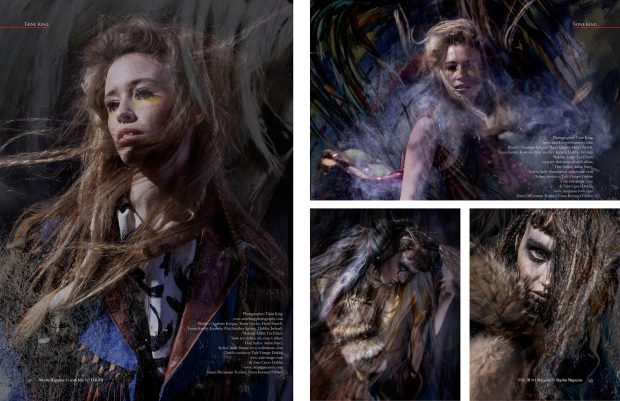
My Concept
My aim was to shoot a beauty editorial where the models will represent the horses (the horses spirit), and for it to be styled around the individual symbol painted on the horse. The Indians painted these to bring their horses different strengths and powers during battle. The aim was for every image with styling, hair and makeup to represent one of these symbols. I chose to shoot four different models to represent different horses individual spirits and unique personalities. I wanted body movement to play a huge part in getting the models to express the spirit of the horses.
I love the clutter and colour of the designs that the native Americans used and I wanted that to come through in my images through styling and movement. Fiona Keenan O Brien a dance teacher went through movements with the models before the shoot to help the models fully express what they were to represent. I also incorporated abstract markings into my final edits so the essence and spirit of the horses is felt in the images. Each model had their own horse and spirit and each of them brought something different to the shoot bringing the ink symbols to life.
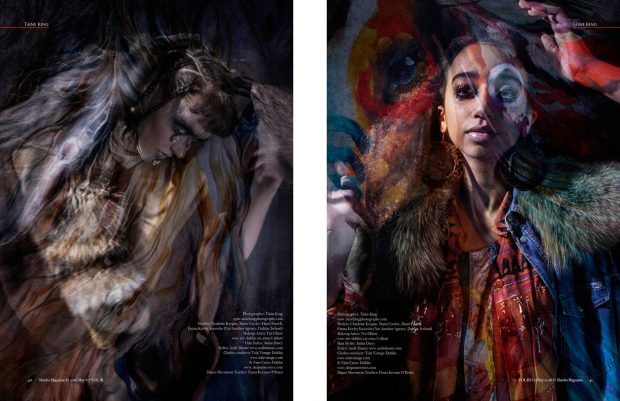
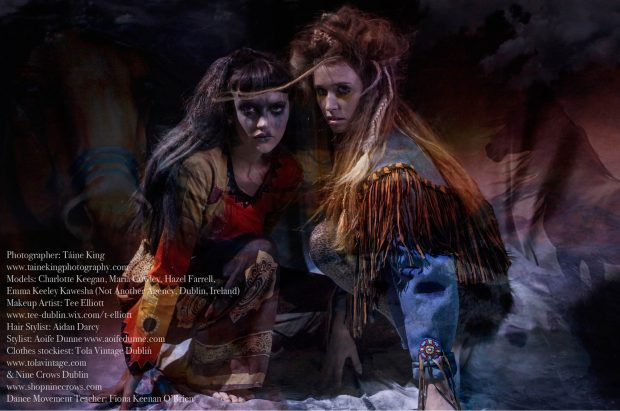
Photographer: Táine King Models: Charlotte Keegan, Maria Cowley, Hazel Farrell, Emma Keeley Kawesha (Not Another Agency, Dublin, Ireland) Makeup Artist: Tee Elliott Hair Stylist: Aidan Darcy Stylist: Aoife Dunne Clothes stockiest: Tola Vintage Dublin & Nine Crows Dublin Dance Movement Teacher: Fiona Keenan O’Brien
Published in May 2016 Volume III: BUY NOW
Read More:
Which finger should I wear a ring on? A guide on ring and finger symbolism

